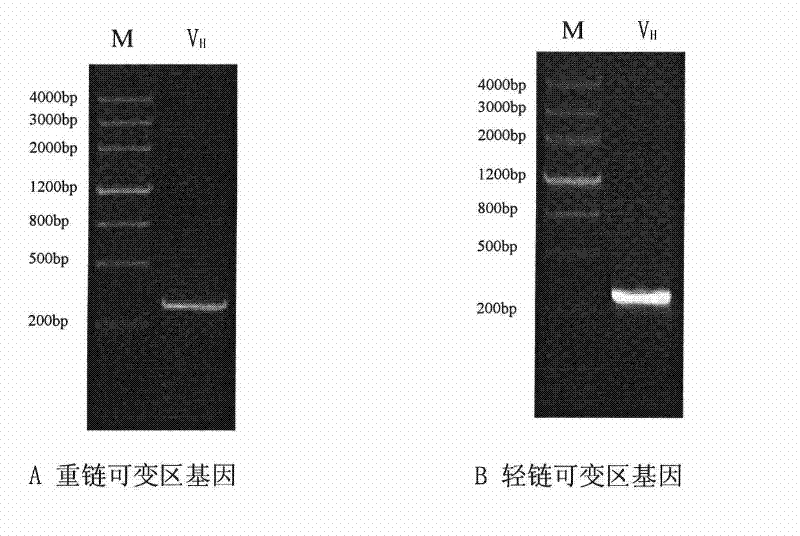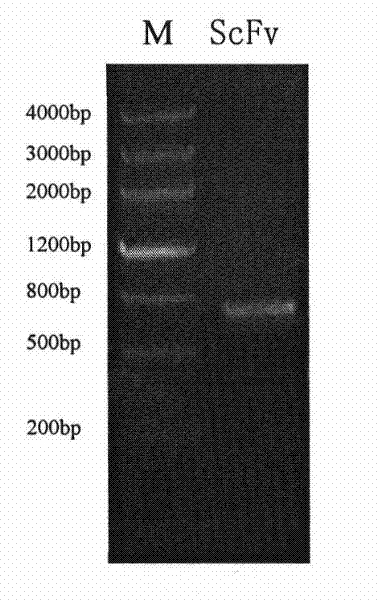Novel targeted fusion protein with anti-inflammatory action and use thereof
A targeted, single-chain antibody technology, applied in the field of gene products, can solve problems such as infection
- Summary
- Abstract
- Description
- Claims
- Application Information
AI Technical Summary
Problems solved by technology
Method used
Image
Examples
Embodiment 1
[0054] Example 1. Acquisition of anti-P-selectin single chain antibody targeting complement inhibitor ScFv-Crry and construction of its eukaryotic expression vector
[0055] 1. Obtaining anti-P-selectin single chain antibody
[0056] Use the following method to screen anti-P-selectin single-chain antibody, and the specific method includes the following steps:
[0057] 1. Cell culture and identification: the hybridoma cells secreting P-selectin antibody (constructed according to the method in Xu Tinggui, 1982.) (cultivated in complete RPMI1640 containing 15% bovine serum) Medium. Incubator with 5% CO 2 The mixed gas has a humidity of 98%. The specificity and titer of the monoclonal antibody in the culture supernatant were identified by ELISA method, and the antibody titer reached 1:3200 with obvious species specificity.
[0058] 2. Isolation and purification of mRNA: use rapid preparation and purification of mRNA kit (Promega) and refer to the kit instructions from about 2 ×...
Embodiment 2
[0072] Example 2, Screening of high-expression cell lines of anti-P-selectin single-chain antibody targeting complement inhibitor ScFv-Crry and purification of anti-P-selectin single-chain antibody targeting complement inhibitor ScFv-Crry
[0073] 1. Screening of cell lines with high expression of anti-P-selectin single chain antibody targeting complement inhibitor ScFv-Crry
[0074] In order to obtain higher biological protein molecules closer to natural in terms of molecular structure, physical and chemical properties and biological functions, the recombinant eukaryotic expression plasmid pEE14.1 / ScFv-Crry obtained in Example 1 was transfected into Chinese hamsters using liposomes Ovarian cells in CHO. After 24 hours of transfection, the medium was sucked off, and 10 mL of fresh selective medium DMEM+10% FCS+25 μm MSX was added. at 5% CO 2 The mixed gas was cultivated in a 37°C incubator with a humidity of 98%. After 2 weeks, clones of about 1-2 mm appeared, and the clones ...
Embodiment 3
[0077] Embodiment 3, in vivo and in vitro biological activity identification and animal experiments
[0078] 1. Complement lysis inhibition experiment
[0079] To measure the inhibitory activity on complement, 60%-80% confluent CHO cells were separated with ethylenediaminetetraacetic acid, washed twice with DMEM, and then resuspended in DMEM to make the final concentration of 10 9 / L. Add 100mL / L rabbit anti-CHO cell membrane antiserum to the cell suspension and react at 4°C for 30min to sensitize the cells. Then the antiserum was discarded, and the cells were resuspended in NHS diluted with DMEM to a final volume of 50 μL or 100 μL. After 60 minutes at 37°C, the cell viability was measured by placenta blue staining and exclusion method (both live and dead cells were counted). The fusion protein ScFv-Crry was diluted with DEME and added to NHS first, and then added to CHO cell suspension. The final concentration was based on the control CHO cells lysed by 100 g / L NHS which...
PUM
 Login to View More
Login to View More Abstract
Description
Claims
Application Information
 Login to View More
Login to View More - R&D
- Intellectual Property
- Life Sciences
- Materials
- Tech Scout
- Unparalleled Data Quality
- Higher Quality Content
- 60% Fewer Hallucinations
Browse by: Latest US Patents, China's latest patents, Technical Efficacy Thesaurus, Application Domain, Technology Topic, Popular Technical Reports.
© 2025 PatSnap. All rights reserved.Legal|Privacy policy|Modern Slavery Act Transparency Statement|Sitemap|About US| Contact US: help@patsnap.com



